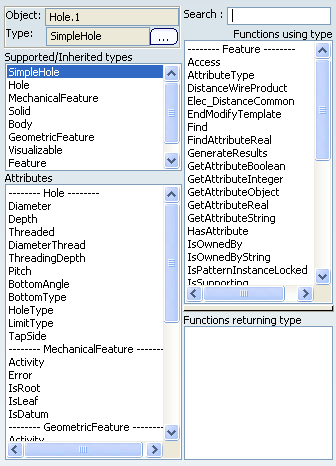About the Expert Check Editor | ||||||
|
| |||||
Condition Tab
This section provides you with information about the Condition Tab.
Actions Toolbar
|
|
Lets you find and replace text. |
|
|
Lets you access a browser of types. To
use this browser, you can either select the objects you
want to work with in the geometry or click the ...
button to select the type in the list.
|
|
|
Lets you reach the line containing the syntax error. |
|
|
Lets you to associate a URL or a comment to the formula. |
|
|
Lets you erase the contents of the edition window. |
To get a full description of the available types, see the Reference Information section of this guide.
For All Field
Indicated by the universal quantifier
![]() ,
this field lets you specify the features the check
is intended to apply to, to declare the variables names and their types.
,
this field lets you specify the features the check
is intended to apply to, to declare the variables names and their types.
- Double-click the Name field to enter the argument name.
- Select the type in the type list.

| Important: Types can be indicated by selecting them in the browser or by clicking the features in the geometrical area or in the specification tree. |
Check Body area
The check body area is designed for keying in in the check body, which is written in the form of a statement to be checked. In operates on the variables specified in the Condition area (see above). Example:
H.Diameter == 50.0 mm
Two contextual commands improving display are available from the contextual menu in the Check Body field:
- Reframe on object under cursor lets you reframe on the feature both in the 3D visualization and in the specification tree.
- Center graph on object under cursor locates the feature in the specification tree.
![]()
Correction Tab
This section provides you with information about the Correction Tab.
The Correction tab is made of 2 different areas:
Correction method
The correction method enables you to key in the correction to be applied when the check is not fulfilled (optional).
| Visual Basic Language | Describes the correction in Visual Basic (See Launching a Check Correction Method). |
| Advise Correction | Displays a comment in the report associated with the rulebase solve or accessed by right-clicking the check in the specification tree and by selecting Correction function. |
| URL | Opens a URL page. |
| Knowledge Language | Describes the correction in Knowledge language and enables you to re-use the variables of the condition area in the body of the correction. |
Correction comment (available for Visual Basic Scripts only)
The message you type in the Correction Comment area will be displayed in the report generated when you click the Report icon of the workbench. It will also be displayed if you right-click the check in the specification tree and select Correction function
